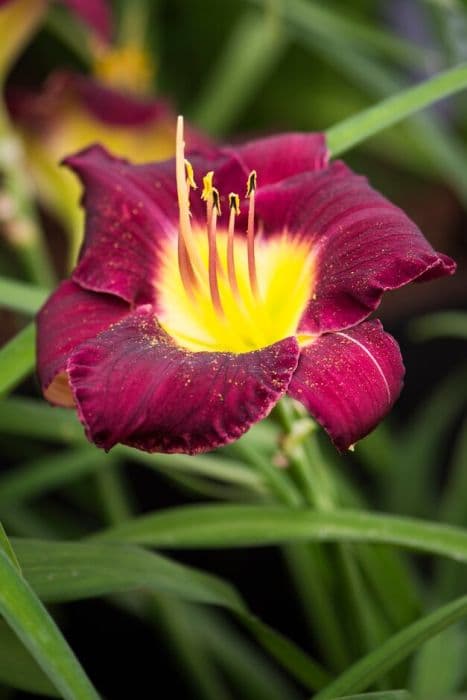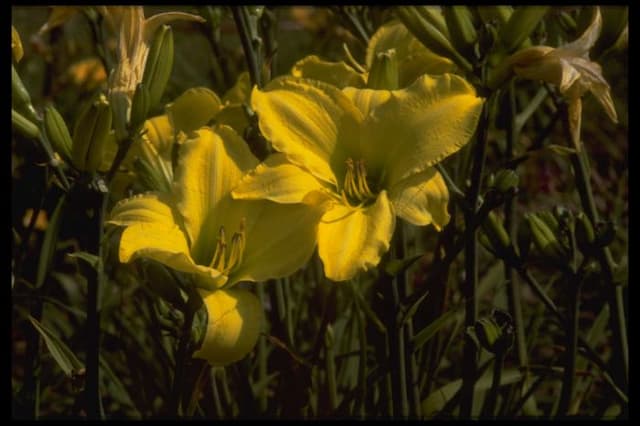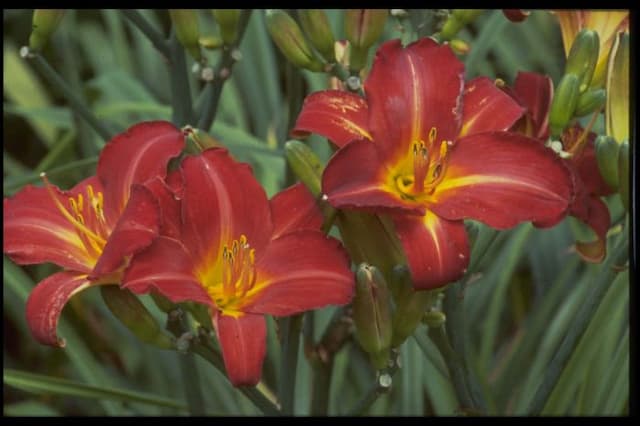Daylily Hemerocallis 'Wind Storm'

ABOUT
Hemerocallis 'Wind Storm' is commonly known as the daylily. This particular variety boasts a stunning display of flowers, characterized by their unique coloration. Each bloom exhibits a blend of rich, warm tones that can range from deep yellows to vibrant reds and oranges, often with a gradation or a splash of contrasting colors in the throat. The petals are broad and may display ruffles or waves along their edges, adding to their allure and flamboyance. The daylily flowers sit atop long, sturdy stalks, known as scapes, which rise elegantly above a base of lush, green foliage. The leaves are strap-like, arching gracefully, and creating a dense clump of greenery at the base of the plant. The foliage serves as a beautiful foil to the eye-catching flowers that typically bloom in abundance during their flowering season. Each individual flower lasts just a day, as the common name suggests, but the plant continues to produce new flowers over a period of several weeks, offering a prolonged display of beauty. Daylilies, including the 'Wind Storm' variety, are valued for their hardiness and ease of cultivation, often thriving in a wide range of conditions and returning faithfully year after year to grace gardens with their enchanting blossoms.
About this plant
 Names
NamesFamily
Hemerocallidaceae
Synonyms
Daylily
Common names
Hemerocallis 'Wind Storm'.
 Toxicity
ToxicityTo humans
The Hemerocallis 'Wind Storm', commonly known as the daylily, is not toxic to humans. In fact, different parts of the daylily, including the flowers and tubers, have been consumed in various cultures. However, it is always crucial to be certain of the identification of any plant before considering it for consumption to avoid unintended ingestion of toxic look-alikes.
To pets
For pets, particularly cats, the daylily is considered highly toxic. If ingested by a cat, even in small amounts, it can cause severe kidney damage leading to kidney failure. Symptoms of poisoning in cats can include vomiting, lethargy, lack of appetite, increased urination followed by decreased or no urination, and possible kidney failure if not treated promptly. Immediate veterinary care is essential if a pet has consumed any part of a daylily plant.
 Characteristics
CharacteristicsLife cycle
Perennials
Foliage type
Deciduous
Color of leaves
Green
Flower color
Mixed
Height
2 feet 24 inches (60 cm)
Spread
2 feet 24 inches (60 cm)
Plant type
Herb
Hardiness zones
3-9
Native area
Asia
Benefits
 General Benefits
General Benefits- Easy to grow - Hemerocallis 'Wind Storm', commonly known as a Daylily, is known for being low maintenance and easy to cultivate, making it suitable for gardeners of all skill levels.
- Drought tolerant - Once established, Daylilies can survive with minimal watering, making them ideal for dry climates or water-wise gardens.
- Pest and disease resistant - They are generally resistant to many pests and diseases, which reduces the need for chemical treatments.
- Adaptable - Daylilies can thrive in a variety of soil types, from sandy to clay, as long as the soil is well-drained.
- Long blooming - They have a lengthy blooming period, with flowers that can last for several weeks, adding long-term color and interest to the garden.
- Attracts pollinators - The colorful blooms attract butterflies and bees, which are important for pollinating other plants in the garden.
- Erosion control - Their root system helps to stabilize soil and can prevent erosion on slopes and embankments.
- Edible parts - Some varieties of Daylilies have edible parts, such as flowers and tubers, that can be used in culinary dishes (though one should be careful to confirm edibility and absence of toxicity before consuming any plant parts).
- Varied colors and forms - Daylilies come in a wide range of colors, sizes, and forms, allowing for diverse design options in the landscape.
 Medical Properties
Medical PropertiesThis plant is not used for medical purposes.
 Air-purifying Qualities
Air-purifying QualitiesThis plant is not specifically known for air purifying qualities.
 Other Uses
Other Uses- The daylily 'Wind Storm' can be used in floral arrangements. The blossoms can add a burst of color and unique shape to both fresh and dried flower displays.
- Daylilies are often used in companion planting to help hide the declining foliage of spring-flowering bulbs, as their leaves remain lush green throughout the season.
- They can serve as a living mulch to suppress weeds due to their dense root systems and foliage once they become established in a garden bed.
- Edible parts of daylilies, like the buds and flowers, are sometimes used in gourmet cuisine to garnish dishes or add a unique flavor to salads.
- Daylily plants can be used for erosion control because they have thick roots that hold soil in place, making them a practical choice for sloped gardens.
- In ponds or water gardens, daylilies can be planted in the surrounding land to offer a visually pleasing transition from the water to the terrestrial garden areas.
- Daylilies can provide habitat and food for pollinators, including bees and butterflies, contributing to the biodiversity of the garden ecosystem.
- Artists and crafters sometimes use daylily flowers to create natural dyes for textiles, offering a range of yellow, orange, and rust colors.
- Individuals engaging in photography often use daylilies as subjects, capturing their fleeting beauty that lasts just for a day in each bloom.
- The strong, fibrous roots of daylilies can be used in the art of basket weaving, especially in traditional crafts where plant fibers are incorporated.
Interesting Facts
 Feng Shui
Feng ShuiThe Daylily is not used in Feng Shui practice.
 Zodiac Sign Compitability
Zodiac Sign CompitabilityThe Daylily is not used in astrology practice.
 Plant Symbolism
Plant Symbolism- Daylily (General) - Often associated with motherhood and mother's devotion due to the plant's daily blooming cycle.
- Beauty - The daylily's vibrant colors and elegant form represent beauty in its natural expression.
- Transience - With each flower typically lasting only a day, the daylily symbolizes the fleeting nature of life’s moments.
- Renewal - As new flowers bloom each day, the daylily symbolizes renewal, hope, and new beginnings.
- Forgetfulness - In the language of flowers, daylilies can represent a disposition to forget worries and past troubles due to their short bloom time.
- Flirtation - The ephemeral beauty of the flowers may suggest a playful, fleeting interest or a light-hearted romance.
 Water
WaterThe Daylily 'Wind Storm' should be watered deeply about once a week, providing about 1 inch of water which is roughly equivalent to 0.6 gallons for an average-sized plant. Ensure the soil is well-drained and water at the base of the plant to keep the leaves dry and prevent any fungal diseases. During periods of extreme heat or drought, increase watering frequency to every 3 to 4 days. Cut back on watering as the weather cools to prevent over-saturation of the soil.
 Light
LightDaylilies, including 'Wind Storm', flourish best in full sunlight which means they should receive at least 6 hours of direct sunlight daily. However, they can tolerate partial shade, particularly in the afternoon to protect them from the scorching heat. The ideal spot would be one where they get the morning sun, which is less intense, and some shade during the hottest part of the day.
 Temperature
TemperatureDaylilies such as the 'Wind Storm' variety prefer temperate climates and are very hardy, tolerating temperatures as low as -20°F and as high as 90°F. Nonetheless, the ideal growth temperatures for daylilies are between 55°F and 75°F. It's important to protect the plant from extreme cold by providing mulch, especially in areas where temperatures dip below freezing.
 Pruning
PruningPruning Daylilies like 'Wind Storm' is done for aesthetic reasons and to promote healthy growth by removing spent flower stalks and dead foliage. Prune them back in early spring or after flowering is finished in the fall. Deadheading, or removing spent blooms, should be done on a regular basis throughout the blooming season to encourage more flowers.
 Cleaning
CleaningAs needed
 Soil
SoilDaylilies, such as the 'Wind Storm', flourish in well-draining soil with a pH between 6.0 and 6.5. A good mix can be made with equal parts of loamy garden soil, compost, and a bit of sand to improve drainage. They are adaptable but avoid heavy, wet soils to prevent root rot.
 Repotting
RepottingDaylilies like 'Wind Storm' are typically perennials planted outdoors and don't require frequent repotting. However, if grown in containers, repot every 2-3 years or when they outgrow their current pot to ensure continued growth.
 Humidity & Misting
Humidity & MistingDaylilies, including 'Wind Storm', are tolerant of a range of humidity levels and do well in the varying outdoor conditions they encounter in gardens. Aim for average garden humidity levels.
 Suitable locations
Suitable locationsIndoor
Daylilies need full sun; hard to grow indoors.
Outdoor
Plant in full sun to partial shade in well-draining soil.
Hardiness zone
3-9 USDA
 Life cycle
Life cycleThe common daylily 'Wind Storm' begins its life as a dormant rhizome or rootstock which, upon planting and with the arrival of warmer spring temperatures, starts to send up shoots. These shoots develop into long, strappy leaves that form a clump and gather energy through photosynthesis. As the plant matures, flower stalks known as scapes emerge from the center of the clump, each bearing multiple flower buds. The buds bloom into large, often colorful, trumpet-shaped flowers, typically lasting just one day before withering, hence the name "daylily." After the flowering period, which may continue through summer as new buds open, the plant focuses on storing energy in the rhizome for the next season. Once colder temperatures arrive, the foliage dies back, and the daylily enters a period of dormancy, repeating the cycle in the following spring.
 Propogation
PropogationPropogation time
Early Spring
The Hemerocallis 'Wind Storm', commonly known as Daylily, is best propagated by division, a process that can be done ideally in either spring or fall. To propagate by division, carefully dig around the established clump of daylilies and lift it out of the ground. Gently shake off excess soil and separate the clump into smaller sections, ensuring each section has a fan of leaves and a portion of the root system. Replant these divisions at the same depth they were originally growing, spacing them about 18 to 24 inches apart (approximately 45 to 60 centimeters), which allows sufficient space for the plants to reach maturity. Water the new plantings well to help establish their roots. This asexual method of propagation maintains the genetic fidelity of the 'Wind Storm' cultivar, ensuring that the new plants will exhibit the same characteristics as the parent.









